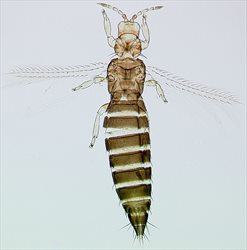
Female

Antenna

Antenna
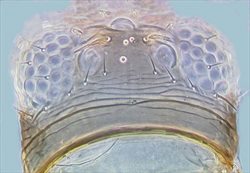
Head
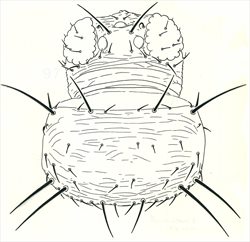
Head & pronotum
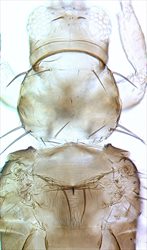
Head & thorax
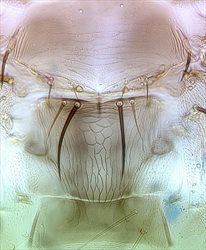
Meso & metanota
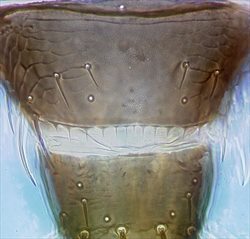
Female tergites VIII-IX
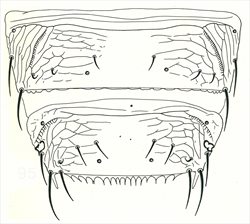
Tergites VII-VIII
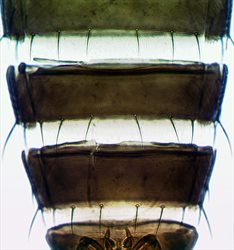
Sternites V–VII
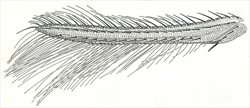
Fore wing
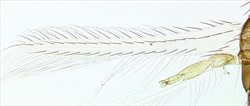
Fore wing
Both sexes fully winged. Body and legs variable in colour, mainly brown with head and pronotum often paler than abdomen, tibiae and tarsi largely yellow; major setae dark; antennal segments III–IV yellow with apices shaded; fore wing pale with setae dark. Antennae 8-segmented; segments III–IV with forked sense cone, segment VIII as long as VII. Head wider than long; three pairs of ocellar setae present, pair III slightly longer than side of ocellar triangle, arising on anterior margins of triangle; postocular setae pair I present, pair IV short, no longer than diameter of hind ocellus. Pronotum with 5 pairs of major setae; anteromarginal setae shorter than anteroangulars, one pair of minor setae present medially between posteromarginal submedian setae; upper surface of fore coxae with microtrichia on sculpture lines. Metanotum with 2 pairs of setae at anterior margin, campaniform sensilla absent. Fore wing with 2 complete rows of veinal setae. Abdominal tergites V–VIII with paired ctenidia, on VIII anterolateral to spiracle; posteromarginal comb on VIII complete, but microtrichia short, slender and arising from triangular bases. Sternites III–VII without discal setae.
Male smaller and paler than female; tergite VIII with no posteromarginal comb; tergite IX with posterolateral setae stout in larger males; sternites III–VII each with transverse pore plate.
This Eurasian species is closely similar to F. occidentalis, but with postocular setae pair IV considerably shorter, and only very rarely with metanotal campaniform sensilla. Currently 230 species are listed in Frankliniella, with up to 130 further names placed into synonymy (Nakahara, 1997). These synonymies result from unrecognized variability in size and colour exhibited by many species. This variation is reflected in the large number of subspecies names listed under intonsa.
Feeding and breeding in flowers, and highly polyphagous. Adults have been taken from a very wide range of plants, often low-lying in the vegetation, and in Britain are often found on Erica [Ericaceae] and Trifolium repens [Fabaceae].
Widespread in Britain, although records have been mainly from the southern counties and are rarer into Scotland (Mound et al., 1976); however, the species is now known to be common in Yorkshire (e.g., Collins, 2006) and the scarcity of northern records may be the result of under-recording. Widespread across Europe from Scandinavia southwards, and through Iran to northern India, southern China, and Taiwan (zur Strassen, 2003), and also Indonesia (Makassar).
THRIPIDAE - THRIPINAE
Frankliniella intonsa (Trybom)
Thrips intonsa Trybom, 1895: 182
Physopus vulgatissima var. nigropilosa Uzel, 1895: 96
Physopus vulgatissima var. fulvicornis Uzel, 1895: 96
Physopus vulgatissima var albicornis Uzel, 1895: 96
Physopus vulgatissima var. adusta Uzel, 1895: 96
Thrips pallida Karny, 1907: 49
Physopus brevistylis Karny, 1908: 278
Frankliniella breviceps Bagnall, 1911: 2
Frankliniella vicina Karny, 1922: 94
Frankliniella intonsa var. maritima Priesner, 1925: 17
Frankliniella formosae Moulton, 1928: 324
Frankliniella formosae f. tricolor Moulton, 1928: 325
Frankliniella intonsa var. rufula Keler, 1936: 104
Frankliniella intonsa f. norashensis Yakhontov & Jurbanov, 1957: 1279
Collins DW (2006) Odontothrips confusus Priesner (Thysanoptera: Thripidae) new to Britain and recent records of other British thrips. British Journal of Entomology and Natural History 19: 145–156.
Mound LA, Morison GD, Pitkin BR & Palmer JM (1976) Thysanoptera. Handbooks for the Identification of British Insects 1 (11): 1–79.
Nakahara S (1997) Annotated list of the Frankliniella species of the world (Thysanoptera: Thripidae). Contributions on Entomology, International 2 (4): 355–389.
zur Strassen R (2003) Die terebranten Thysanopteren Europas und des Mittelmeer-Gebietes. Die Tierwelt Deutschlands 74: 1–271.